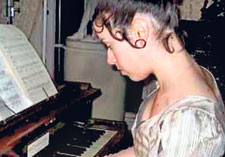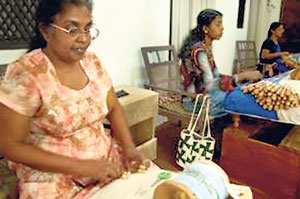Galle lace, Beeralu lace, Portuguese lace, you have heard about it, but have you seen it? Bought it? Used it? A legacy of Portuguese colonization, beeralu lace making has long been considered a traditional craft of Sri Lanka. Today, a small concentration of women still continue this craft mainly in the Magalle area of Galle but it is an art form in crisis. They fight old age, poor market conditions and poverty to keep the craft going.
 |
| Actress Sally Hawkins wears a costume designed by Andrea Galer using Galle lace in the movie Persuasion |
Lace-making is a delicate and difficult craft. Before weaving the lace the lace-makers need to prepare a stencil (or Esbisalaya in Sinhala).To create a stencil the lace-maker needs to know all the different types of knots used in lace-making. The stencil is made on a piece of cardboard using graph paper. The pattern of the lace is traced onto the paper which is then fixed onto the rotatable structure of the beeralu kotte or pillow, the wooden structure used to make lace. They then weave over 30 wooden bobbins or beeralu, creating their pattern using pins where necessary in the design to separate the different kinds of knots. The craft is so intricate that it takes an experienced lace maker about a week to create a metre of one inch wide lace.
Priyani is one of the lace-makers of Magalle. Like most lace-makers, the craft had been handed down from mother to daughter in Priyani’s family, for generations. She picked up lace-making from her mother and developed her skills into a fulltime business. She started off by selling to individuals who would buy her products and then resell them. Over the years her business grew and she was able to employ 12 women, to produce items such as cushion covers, table cloths and clothing trimmed with beeralu lace, at her home. She also had over 200 outreach workers.
The list of awards Priyani has won for her lace designs as well as her entrepreneurial skills is as long as my arm, including two presidential awards in 1993 and 1997. Even today Priyani is looking for new and interesting ways to present and market her lace. The tsunami in 2004 washed away her business and her awards but slowly with the aid of NGOs and supportive individuals she rebuilt her home and her lace-making business. Though only her daughter and herself work at her home today, around 250 women still bring the lace they weave at their homes to her for sale.
Now however, her sewing machines are silent, the beeralu pillows idle. Priyani has stopped production for the moment because of the lack of buyers. The market for lace and lace products is very poor, she says: “Tourism is slow, the big hotels in Colombo have stopped buying lace… I have stopped production for now.”
The lack of a market and fair prices for beeralu lace are two of the main problems faced by the lace-makers of Galle. Beeralu lace is not popular among Sri Lankans which leaves the lace-makers dependent on the foreign market and tourists. Mass production and cheaper imports have pushed hand-made lace out of local markets. If the local attitude towards hand-made lace changed, it could change the face of the beeralu lace industry. Most of these women sell their lace to traders for a pittance. These traders resell the lace for three or four times the price they pay the makers who have no first hand access to the market.
Very few are as fortunate to develop their trade as far as Priyani has. Leelawathi, another lace-maker from the Magalle area learnt lace-weaving from her grandmother at the age of twelve and took it up as an occupation after marriage. Those were the good old times when lace was popular among rich upper-class women, she says. There were only a few women making lace and demand was high. Leelawathi sold most of her lace to a buyer at a major hotel in Colombo and made a good living.
However, 81 years old today, she is frail and her eyesight is failing. In her old age a skilled lace-maker who produced masterpieces in her heyday is left helpless.
Lace-making, like many other crafts in Sri Lanka, lacks institutionalized training facilities where the younger generations can learn the craft and experienced lace-makers can share and improve their skills. Such a training facility would give experienced lace-makers like Leelawathi the opportunity to disseminate their knowledge and preserve the art. It would also give them an opportunity to support themselves while maintaining a sense of self-worth in their old age. If such training and educational facilities were available, the younger generations who abandon lace-making for more lucrative professions, will learn to respect lace-making as a serious profession and a valuable art form.
Where will Galle lace be ten years from now? A thing of the past? A museum display? It may be a sad truth, but it would not be as sad as it is to see women with such skill desperate and without any reasonable income.
The Power of Hands lends a much needed hand
In March 2005, Andrea Galer, a famous UK costume and fashion designer, came to Sri Lanka to see what she could do to help the lace-making women in Galle whose situation had become even more desperate after the tsunami in 2004.
Andrea established the Power of Hands Foundation (POHF) to help the women survive and show people their wonderful skill while helping them earn fair prices for their work.
In 2008 Power of Hands became a UK registered charity. It also provides marketing expertise and operational support to help the women to create craft products of a type and quality which can help provide them with a sustainable future, while reviving the craft.
 |
| Weaving lace at the POH workshop |
At present the POHF has established a workshop in the Galle Fort that provides a clean and safe environment where seven lace makers make lace on a full-time basis. This is also the base for a co-operative society of over eighty lace makers who produce lace in their own homes and visit the workshop regularly to be paid and collect new orders. The foundation is currently being managed by Anusha Liyanage, who has a passion for the craft.
Parallel to the Power of Hands Foundation, Power of Hands Limited has also been established to create a market for the lace in the UK, with the development of ethical fair trade which is the main focus of the project.
“These women have to earn fair trade prices for their work or they have to stop,” emphasises Andrea. Initially Power of Hands Limited targeted costume designers, fashion designers and theatres resulting in Galle lace appearing in productions at the Royal Opera House and on costumes of award winning British films.
Andrea has used Beeralu lace in her costumes for award winning film such as Persuasion, Jane Eyre and Miss Austen Regrets and organized the production of some of the lace and tatting for the major Oscar winning film Golden Age by costume designer Alexandra Byrne.
 |
| Andrea Galer |
The POHF lends these lace-makers a much needed hand, but even the foundation is now bringing in fewer orders. Right now they have no orders to give the women, but hopefully the situation will improve soon. As Andrea sees it, “A great deal more needs to be done in design and marketing to hit the global market and provide the women with a safe future”.
POHF also hopes to set up three new craft workshops and training centres, together with a co-operative of at least 100 women for each, in different locations throughout southern Sri Lanka.
They seek assistance and support of individuals and organizations willing to lend a hand to make the lives of the craft makers a little easier.
“Power of Hands is not about buying and selling lace,” says Andrea, “but about how the women can utilize their skills.”
For more information: www.powerofhandsfoundation.org |
